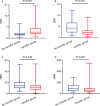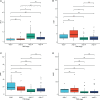Immune cell-lipoprotein imbalance as a marker for early diagnosis of non-small cell lung cancer metastasis
- PMID: 36353553
- PMCID: PMC9638068
- DOI: 10.3389/fonc.2022.942964
Immune cell-lipoprotein imbalance as a marker for early diagnosis of non-small cell lung cancer metastasis
Erratum in
-
Corrigendum: Immune cell-lipoprotein imbalance as a marker for early diagnosis of non-small cell lung cancer metastasis.Front Oncol. 2022 Dec 15;12:1118042. doi: 10.3389/fonc.2022.1118042. eCollection 2022. Front Oncol. 2022. PMID: 36591456 Free PMC article.
Abstract
The underlying molecular mechanisms and evolutionary patterns of lung cancer metastasis remain unclear, resulting in a lack of effective indicators for early diagnosis of metastasis. We retrospectively analyzed 117 patients with primary non-small cell lung cancer (NSCLC) admitted to Tongji Hospital of Tongji University in 2021, of which 93 patients with tumor metastasis were set as the metastasis group. 24 patients without metastasis were set as the non-metastasis group. The differences of each index in the two groups of patients and the expression levels in different TNM stages were compared. This study intends to evaluate the diagnostic value and net clinical benefit of common blood-related indicators Neutrophil/lymphocyte (NLR), lymphocyte/monocyte (LMR), High density lipoprotein/neutrophil (HNR), High density lipoprotein/monocyte (HMR) and combined assays in NSCLC metastasis for the early diagnosis of patients with NSCLC metastasis. It was found that the level of NLR was higher in metastatic NSCLC than non-metastatic, but the level of LMR, HNR and HMR was lower. The levels of NLR, LMR, HNR and HMR in patients with different TNM stages showed that NLR levels increased with TNM stage, while LMR, HNR and HMR levels decreased. The threshold probability range of the 4 combined tests was greater and the overall clinical benefit rate was higher compared to the individual tests. Our findings suggest that NLR, LMR, HNR and HMR have better diagnostic value for NSCLC metastasis. This study provides a clinical basis for investigating the mechanisms by which immune cells and lipid metabolism-related proteins remodel the microenvironment prior to NSCLC metastasis.
Keywords: HNR; LMR; NLR; NSCLC; diagnostic markers; risk assessment.
Copyright © 2022 Zhang, Wang, Wu, Tian, Yan, Yuan, Yao, Shang and Quan.
Conflict of interest statement
The authors declare that the research was conducted in the absence of any commercial or financial relationships that could be construed as a potential conflict of interest.
Figures








Similar articles
-
Corrigendum: Immune cell-lipoprotein imbalance as a marker for early diagnosis of non-small cell lung cancer metastasis.Front Oncol. 2022 Dec 15;12:1118042. doi: 10.3389/fonc.2022.1118042. eCollection 2022. Front Oncol. 2022. PMID: 36591456 Free PMC article.
-
Preoperative platelet-lymphocyte ratio is a superior prognostic biomarker to other systemic inflammatory response markers in non-small cell lung cancer.Medicine (Baltimore). 2020 Jan;99(4):e18607. doi: 10.1097/MD.0000000000018607. Medicine (Baltimore). 2020. PMID: 31977852 Free PMC article.
-
Prognostic biomarkers in stage IV non-small cell lung cancer (NSCLC): neutrophil to lymphocyte ratio (NLR), lymphocyte to monocyte ratio (LMR), platelet to lymphocyte ratio (PLR) and advanced lung cancer inflammation index (ALI).Transl Lung Cancer Res. 2019 Dec;8(6):886-894. doi: 10.21037/tlcr.2019.11.16. Transl Lung Cancer Res. 2019. PMID: 32010567 Free PMC article.
-
Combined prognostic value of the SUVmax derived from FDG-PET and the lymphocyte-monocyte ratio in patients with stage IIIB-IV non-small cell lung cancer receiving chemotherapy.BMC Cancer. 2021 Jan 14;21(1):66. doi: 10.1186/s12885-021-07784-x. BMC Cancer. 2021. PMID: 33446134 Free PMC article.
-
Systemic Inflammatory Markers of Survival in Epidermal Growth Factor-Mutated Non-Small-Cell Lung Cancer: Single-Institution Analysis, Systematic Review, and Meta-analysis.Clin Lung Cancer. 2021 Sep;22(5):390-407. doi: 10.1016/j.cllc.2021.01.002. Epub 2021 Jan 10. Clin Lung Cancer. 2021. PMID: 33582072
Cited by
-
Prediction model for the early recurrence of stage IA-IIA non-small cell lung cancer based on hematological indexes and imaging features.Discov Oncol. 2025 May 7;16(1):684. doi: 10.1007/s12672-025-02514-2. Discov Oncol. 2025. PMID: 40335771 Free PMC article.
References
-
- Rice SR, Saboury B, Houshmand S, Salavati A, Kalbasi A, Goodman CR, et al. . Quantification of global lung inflammation using volumetric 18F-FDG PET/CT parameters in locally advanced non-small-cell lung cancer patients treated with concurrent chemoradiotherapy: A comparison of photon and proton radiation therapy. Nucl Med Commun (2019) 40:618–25. doi: 10.1097/MNM.0000000000000997 - DOI - PubMed
LinkOut - more resources
Full Text Sources

